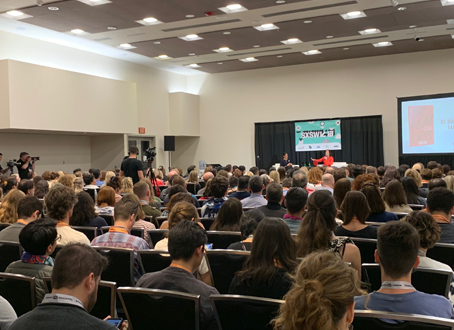It started with a little campaign to raise money for making potato salad. It went viral, raising $55,000 and became one of the highest-viewed campaigns in Kickstarter history. Some rolled their eyes, thinking that this just showed all that was wrong with crowdfunding. Others thought this was a breakthrough moment – a crowdfunding campaign, albeit a silly one, was making national and international news and bringing the concept into homes everywhere. And no matter what their viewpoint, pretty much everyone was left wondering, is this a joke?
This is where we started the conversation at a panel I had the opportunity to moderate last week on the Next Stage at SXSW, featuring Zack Brown, the “Potato Salad Kickstarter guy,” Ryan Grepper, CEO of the Coolest Cooler (the second highest-grossing Kickstarter campaign, raising $13.3 million) and Gary Wohlfeill, director of marketing at Crowdrise, a crowdfunding platform focused on raising money for causes and nonprofits.
We had a fun conversation focused on tips and tricks for creating a successful crowdfunding campaign , how to harness crowdfunding for good and the future of the industry. Here are a few takeaways from our conversation:
• Content is king – For those of you who are familiar with the Coolest Cooler (which really is the coolest cooler I’ve seen), it seems obvious to us now that it would be a product in high demand. But what many don’t know is that the first Kickstarter campaign for the product actually failed to reach its goal. The reason? The lack of simple, creative and compelling content, according to Grepper. The second, wildly successful campaign for the Cooler featured a simple, straightforward video that captured the imagination of anyone visiting the site right from the start. Similarly, Zack Brown noted that his goal in developing content for the Potato Salad campaign was to keep it minimal and to the point. And while yes, the campaign was in fact designed to be a joke, the panel agreed that no doubt the nature of the language used in the campaign page drew people in and excited them about being “in” on the joke. Another proponent of good content and the importance of tone is Gary Wolfheil, who pointed out Crowdrise’s mission to “make giving fun.” And so it’s no surprise that the campaigns that do best on the platform are entertaining and engaging.
• Successful crowdfunding campaigns are based on equity – No, we’re not talking about securities-based crowdfunding here (we’ll get to that a little later), but rather a point that Gary Wohlfeill raised – successful campaigns make you feel like you have some sort of equity and stake in its success. This type of equity can be physical (i.e., receiving an actual product like the Coolest Cooler), community-based (like taking part in Zack Brown’s “Potato Stock”) or emotional (Wohlfeill shared an example of a young woman raising money for a family in Haiti who attracted participants in the campaign by promising video footage for every milestone reached – including the family moving into a new home).
• Wild success is a good thing – for the most part. In both the case of Potato Salad and the Coolest Cooler, the campaigns surpassed not only the initial fundraising goal but the organizers’ wildest expectations. Which is largely a good thing – but not without its pitfalls: from criticisms to how the money might be used to challenges in delivering product. In both cases, transparency and pivots were key to the success of the campaign – and the days that followed. On Brown’s side, as the campaign continued to blow through new stretch goals, he posted regular updates to the site to share new plans with supporters, which ultimately led to the development of not only the giant potato party known as Potato Stock, but a partnership with The Columbus Foundation, turning the energy around potato salad into a force for good. For Grepper, the campaign’s wild success meant manufacturing exponentially more Coolest Coolers than he had initially planned – which ultimately meant delays. Grepper has been incredibly transparent about the entire process – posting numerous lengthy updates to the campaign page and sharing with backers – giving them an inside view of the project and how it’s progressing (and rewarding them for their patience with even more features).
• Crowdfunding has unleashed incredible human generosity. At the Case Foundation, we’ve long known about the transformative possibilities of combining a large number of small gifts, having supported platforms like Network for Good and MissionFish, that have collectively raised more than $1.5B for nonprofits. And we’ve seen crowdfunding used in big ways to rally around individuals in need – $700K for a vacation for a bullied bus monitor, or $350K for the man in Detroit with a 21-mile walking commute (though it should be noted that these success stories are not without their critics and downsides). But, as Wolfheil pointed out, all you have to do is surf the Crowdrise site to see generosity on display at a smaller, but equally as meaningful scale. Brown and Grepper agreed that there was tremendous power to direct the energy that a crowdfunding campaign can generate towards making the world a better place.
• The future of crowdfunding is bright (but maybe a little complicated). In 2014, crowdfunding campaigns raised an estimated $10 billion, and the industry is expected to grow to $20 billion in 2015. My fellow panelists all seemed to agree that the industry is poised for continued exponential growth – pointing out that we’ve barely just scratched the surface when it comes to crowdfunding becoming a mainstream phenomenon. When it comes to new types of crowdfunding – and specifically securities-based crowdfunding for non-accredited investors (meaning anyone will be able to contribute to a campaign in exchange for a financial stake in a company), which is awaiting finalization of SEC rules – the panel was mixed. Based on his experience in managing a wide range of comments and criticisms in his product-based campaign, Grepper raised concerns over how company founders will effectively manage such a large pool of investors. But most were intrigued about the potential of equity crowdfunding if implemented right.
At the end of the discussion, we revisited the opening question: did the Potato Salad campaign kill or save crowdfunding? At the end of the day, we realized that it wasn’t really the right question to ask. Rather, it was how can we continue to unlock the power of crowdfunding to drive new innovations, advance game-changing projects and ultimately harness energy and dollars to change the world? Sometimes, it might take a little bit of humor and a lot of potato salad.





